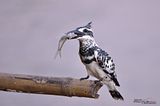Photos taken from Beppu Park earlier this month. After the finding of the Ryukyu Minivet on January 12th, I went back again on the next morning hoping to get some better shots. The bird was nowhere to be found, by the way. So I spent time taking photos of other common birds around the park instead. I was surprise to see that a small flock of Eurasian Siskins was still lingering inside the park. I thought all of them have already moved further south. There were a few Hawfinches, as well as a pair of White-bellied Green Pigeons, of which I could almost take some nice photos while they were coming down to drink, but flew away just before I pressed the shutter button. Other stuff like Pale and Dusky Thrushes, Grey-capped Greenfinches and Daurian Redstarts were all presenting well as usual.
This male Daurian Redstart (Phoenicurus auroreus) was staying at the northeast gate of the park. It was so tame that I didn't have to crop all of the images above, well, simply because there's already no space to crop. It was foraging on fallen berries underneath a fruited tree. There were a few more individuals in the other areas of the park, but not as numerous as during the autumn passage.




Dusky Thrush (Turdus eunomus)
 Carrion Crow (Corvus corone)
Carrion Crow (Corvus corone)There seemed to be an influx of Olive-backed Pipits (Anthus hodgsoni) in the pine zones of the park. More than 10 birds were busy walking all over the ground looking for something to eat, not really sure what. I tried to photograph these birds and found it really difficult. They were all very energetic and didn't stop walking for even a second. I had to use flash to help make the photos sharper, since the area where they were feeding was very dark. Some of the birds looked really pale, while some looked much buffier. I wondered if a single or two Tree Pipits (Anthus trivialis) might have sneaked in, but after checking all of the photos, I found none.































































.jpg)
